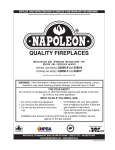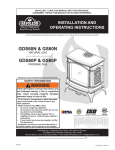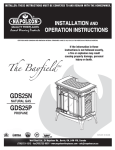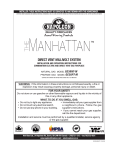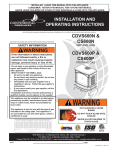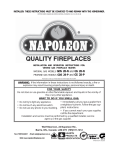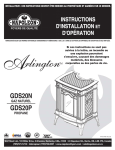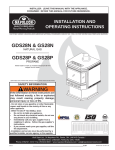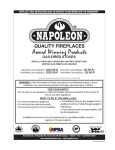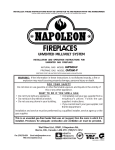Download Continental Fireplaces CDVS600-N Operating instructions
Transcript
1 CERTIFIED UNDER CANADIAN AND AMERICAN NATIONAL STANDARDS, CSA 2.33, ANSI Z21.88 FOR VENTED GAS FIREPLACE HEATERS INSTALLATION AND OPERATION INSTRUCTIONS FOR: VENTED GAS FIREPLACE HEATER NATURAL GAS MODELS CDVS600-N and CS600-N PROPANE GAS MODELS CDVS600-P and CS600-P Model CS600 is made up of Model CDVS600 and the Adapter Kit GS-150KT WARNING: If the information in these instructions is not followed exactly, a fire or explosion may result causing property damage, personal injury or death. FOR YOUR SAFETY Do not store or use gasoline or other flammable vapours and liquids in the vicinity of this or any other appliance. WHAT TO DO IF YOU SMELL GAS: • Do not try to light any appliance. • Do not touch any electrical switch. • Do not use any phone in your build ing. • Immediately call your gas supplier from a neighbour's phone. Follow the gas supplier's instructions. • If you cannot reach your gas supplier, call the fire department. Installation and service must be performed by a qualified installer, service agency or the gas supplier. W415-0162 / E / 03.05.04 2 TABLE of CONTENTS Pg 2-4 INTRODUCTION Pg 14 Warranty General Instructions General Information Care of Glass & Plated Parts Shipping Bracket 5 6-12 GAS INSTALLATION 15-16 FINISHING LOCATION & CLEARANCES DIRECT VENT SPECIFICS MODEL CDVS600 Vent Lengths/Air Terminal Locations Special Installation Example Offset Installation Example Horizontal Terminations Orifice Replacement Top Vent to Rear Vent Modification Venting Parameters Wall & Ceiling Protection Horizontal Venting Installation Vertical Venting Installation Stove Vent Connection Mobile Home Installation 13-14 B-VENT SPECIFICS MODEL CS600 Chimney Installation 'B' Vent Installation Combustion Air Adding Vent Sections Flashing and Storm Collar Installation Logo Placement Front Cast Installation Glass Door Closing & Opening Log Placement 17-18 OPERATION / MAINTENANCE Spill Switch Venting Action Check Operating Instructions Maintenance 19 19 BLOWER INSTALLATION ADJUSTMENTS Pilot Burner Adjustment Venturi Adjustments Restricting Vertical Vents 20-21 REPLACEMENTS Ordering Replacement Parts Termination Kits Replacement Parts Accessories 22-23 TROUBLE SHOOTING GUIDE 24 SERVICE HISTORY PLEASE RETAIN THIS MANUAL FOR FUTURE REFERENCE WARNING • The stove is a vented gas-fired heater. Do not burn wood or other materials in this stove. • Adults and especially children should be alerted to the hazards of high surface temperatures and should stay away to avoid burns or clothing ignition. Supervise young children when they are in the same room as the stove. • Due to high temperatures, the stove should be located out of traffic and away from furniture and draperies. • Clothing or other flammable material should not be placed on or near the stove. • Any safety screen or guard removed for servicing must be replaced prior to operating the stove. • It is imperative that the control compartments, burners and circulating blower and its passageway in the stove and venting system are kept clean. The stove and its venting system should be inspected before use and at least annually by a qualified service person. More frequent cleaning may be required due to excessive lint from carpeting, bedding material, etc. The stove area must be kept clear and free from combustible materials, gasoline and other flammable vapours and liquids. • Under no circumstances should this stove be modified. • This stove must not be connected to a chimney flue pipe serving a separate solid fuel burning appliance. • Do not use this stove if any part has been under water. Immediately call a qualified service technician to inspect the stove and to replace any part of the control system and any gas control which has been under water. • Do not operate the stove with the glass door opened, cracked or broken. Replacement of the glass should be done by a licensed or qualified service person. • Do not strike or slam shut the stove glass door. • This fireplace uses and requires a fast acting thermocouple. Replace only with a fast acting thermocouple supplied by Wolf Steel Ltd. NOTE: changes, other than editorial, are denoted by a vertical line in the margin. W415-0162 / E / 03.05.04 3 CONTINENTAL gas fireplaces are manufactured under the strict Standard of the world recognized ISO 9001 : 2000 Quality Assurance Certificate. CONTINENTAL products are designed with superior components and materials, assembled by trained craftsmen who take great pride in their work. The burner and valve assembly are leak and test-fired at a quality test station. Once assembled the complete fireplace is thoroughly inspected by a qualified technician before packaging to ensure that you, the customer, receives the quality product that you expect from WOLF STEEL Ltd.. CONTINENTAL GAS FIREPLACE PRESIDENT'S LIFETIME LIMITED WARRANTY The following materials and workmanship in your new CONTINENTAL gas fireplace are warranted against defects for as long as you own the fireplace. This covers: combustion chamber, heat exchanger, stainless steel burner, phazer™ logs and embers, ceramic glass (thermal breakage only), gold plated parts against tarnishing, porcelainized enamelled components and aluminium extrusion trims. Electrical (110V and millivolt) components and wearable parts such as blowers, gas valves, thermal switch, switches, wiring, remote controls, igniter, gasketing, and pilot assembly are covered and WOLF STEEL LTD. will provide replacement parts free of charge during the first year of the limited warranty. Any labour related to warranty repair is not covered. CONDITIONS AND LIMITATIONS WOLF STEEL LTD. warrants its products against manufacturing defects to the original purchaser only -- i.e., the individual or legal entity (registered customer) whose name appears on the warranty registration card filed with WOLF STEEL Ltd. -- provided that the purchase was made through an authorized CONTINENTALdealer and is subject to the following conditions and limitations: This factory warranty is nontransferable and may not be extended whatsoever by any of our representatives. The gas fireplace must be installed by a licenced, authorized service technician or contractor. Installation must be done in accordance with the installation instructions included with the product and all local and national building and fire codes. This limited warranty does not cover damages caused by misuse, lack of maintenance, accident, alterations, abuse or neglect and parts installed from other manufacturers will nullify this warranty. This limited warranty further does not cover any scratches, dents, corrosion or discolouring caused by excessive heat, abrasive and chemical cleaners nor chipping on porcelain enamel parts, mechanical breakage of PHAZER™ logs and embers, nor any venting components used in the installation of the fireplace. WOLF STEEL Ltd. warrants its stainless steel burners against defects in workmanship and material for life, subject to the following conditions: During the first 10 years WOLF STEEL Ltd. will replace or repair the defective parts at our option free of charge. From 10 years to life, WOLF STEEL LTD. will provide replacement burners at 50% of the current retail price. In the first year only, this warranty extends to the repair or replacement of warranted parts which are defective in material or workmanship provided that the product has been operated in accordance with the operation instructions and under normal conditions. After the first year, with respect to this President's Limited Lifetime Warranty, WOLF STEEL LTD. may, at its discretion, fully discharge all obligations with respect to this warranty by refunding to the original warranted purchaser the wholesale price of any warranted but defective part(s). WOLF STEEL Ltd. will not be responsible for installation, labour, or any other costs or expenses related to the reinstallation of a warranted part, and such expenses are not covered by this warranty. Notwithstanding any provisions contained in this President's Limited Lifetime Warranty, WOLF STEEL’S responsibility under this warranty is defined as above and it shall not in any event extend to any incidental, consequential or indirect damages. This warranty defines the obligations and liability of WOLF STEEL Ltd. with respect to the CONTINENTAL gas fireplace and any other warranties expressed or implied with respect to this product, its components or accessories are excluded. WOLF STEEL Ltd. neither assumes, nor authorizes any third party to assume, on its behalf, any other liabilities with respect to the sale of this product. WOLF STEEL Ltd. will not be responsible for: over-firing, downdrafts, spillage caused by environmental conditions such as rooftops, buildings, nearby trees, hills, mountains, inadequate vents or ventilation, excessive venting configurations, insufficient makeup air, or negative air pressures which may or may not be caused by mechanical systems such as exhaust fans, furnaces, clothes dryers, etc. Any damages to fireplace, combustion chamber, heat exchanger, brass trim or other component due to water, weather damage, long periods of dampness, condensation, damaging chemicals or cleaners will not be the responsibility of WOLF STEEL Ltd. The bill of sale or copy will be required together with a serial number and a model number when making any warranty claims from your authorized dealer. The warranty registration card must be returned within fourteen days to register the warranty. WOLF STEEL Ltd. reserves the right to have its representative inspect any product or part thereof prior to honouring any warranty claim. ALL SPECIFICATIONS AND DESIGNS ARE SUBJECT TO CHANGE WITHOUT PRIOR NOTICE DUE TO ON-GOING PRODUCT IMPROVEMENTS. NAPOLEON® IS A REGISTERED TRADEMARK OF WOLF STEEL LTD. PATENTS U.S. 5.303.693.801 - CAN. 2.073.411, 2.082.915. © WOLF STEEL LTD. W415-0162 / E / 03.05.04 4 GENERAL INSTRUCTIONS THIS GAS STOVE SHOULD BE INSTALLED AND SERVICED BY A QUALIFIED INSTALLER to conform with local codes. Installation practices vary from region to region and it is important to know the specifics that apply to your area, for example: in Massachusetts State: • The fireplace damper must be removed or welded in the open position prior to installation of a fireplace insert or gas log. • The appliance off valve must be a “T” handle gas cock. • The flexible connector must not be longer than 36 inches. • The appliance is not approved for installation in a bedroom or bathroom unless the unit is a direct vent sealed combustion product. • WARNING: This product must be installed by a licensed plumber or gas fitter when installed within the commonwealth of Massachusetts. In absence of local codes, install to the current CAN1-B149 Installation Code in Canada or to the National Fuel Gas Code, ANSI Z223.1, and NFPA 54 in the United States. Mobile home installation must conform with local codes. In the absence of local codes, install to the current standard for gas equipped mobile housing CAN/CSA Z240 MH Series in Canada or the manufactured home construction and safety standard, Title 24 CFR, part 3280, or the Fire Safety Criteria for manufactured home installations, Sites and Community Standard ANSI/NFPA 501A in the United States. Purge all gas lines with the glass door of the stove removed. Assure that a continuous gas flow is at the burner before reinstalling the door. Under extreme vent configurations, allow several minutes (515) for the flame to stabilize after ignition. It is recommended that all horizontal runs have a ¼ inch rise per foot. Objects placed in front of the stove must be kept a minimum of 48" away from the front face of the unit. The stove and its individual shutoff valve must be disconnected from the gas supply piping system during any pressure testing of that system at test pressures in excess of 1/2 psig (3.5 kPa). The stove must be isolated from the gas supply piping system by closing its individual manual shutoff valve during any pressure testing of the gas supply piping system at test pressures equal to or less than ½ psig (3.5 kPa). The stove, when installed with a blower, must be electrically connected and grounded in accordance with local codes. In the absence of local codes, use the current CSA C22.1 CANADIAN ELECTRICAL CODE in Canada or the ANSI/NFPA 70-1996 NATIONAL ELECTRICAL CODE in the United States. The blower power cord must be connected into a properly grounded receptacle. The grounding prong must not be removed from the cord plug. GENERAL INFORMATION FOR YOUR SATISFACTION, THIS STOVE HAS BEEN TESTFIRED TO ASSURE ITS OPERATION AND QUALITY! Minimum inlet gas supply pressure is 4.5 inches water column for natural gas and 11 inches water column for propane. Maximum inlet gas pressure is 7 inches water column for natural gas and 13 inches water column for propane. When the valve is set to "HI", the manifold pressure under flow conditions is 3.5 inches water column for natural gas and 10 inches water column for propane. When the fireplace is installed at elevations above 4,500ft, and in the absence of specific recommendations from the local authority having jurisdiction, the certified high altitude input rating shall be reduced at the rate of 4% for each additional 1,000ft. W415-0162 / E / 03.05.04 Change in flame appearance from "HI" to "LO" is more evident in natural gas than in propane. Expansion / contraction noises during heating up and cooling down cycles are normal and to be expected. This appliance is only for use with the type of gas indicated on the rating plate. (See page 14). This appliance is not convertible for use with other gases, unless a certified kit is used. INSTALLER: It is your responsiblity to check off the appropriate box on the rating plate according to the model, venting and gas type of the unit. CARE OF GLASS, AND PLATED PARTS Do not use abrasive cleaners to clean these parts. Buff lightly with a clean dry cloth. The glass is 3 /16 " ceramic glass available from your Continental / Wolf Steel Ltd. dealer. DO NOT SUBSTITUTE MATERIALS. Clean the glass after the first 10 hours of operation with a recommended gas fireplace glass cleaner. Thereafter clean as required. DO NOT CLEAN GLASS WHEN HOT! If the glass is not kept clean permanent discolouration and / or blemishes may result. SHIPPING BRACKET To avoid the stove being damaged during shipping, a shipping bracket has been used and must be unbolted before the stove can be installed. 1. Remove the four nuts holding the shipping bracket to the bottom of the stove. 2. Lift the stove up and away from the skid to clear the threaded bolts sticking through the bracket. Set down on a flat surface. The stove top is not secured to the unit. 3. Discard the nuts, bracket and the skid. FIGURE 1 4 NUTS SHIPPING BRACKET CDVS600: TOP VENT / REAR VENT VERTICAL TERMINATION: Maximum input is 35,000 BTU/hr for natural gas and 31,500 BTU/hr for propane. Maximum output for natural gas is 27,300 BTU/hr at an efficiency of 78%. Maximum output for propane is 24,570 BTU/hr at an efficiency of 78%. Maximum A.F.U.E. (annual fuel utilization efficiency) rating is 72% for natural gas and 71% for propane. REAR VENT HORIZONTAL TERMINATION: Maximum input is 21,000 BTU/hr for natural and propane gas. This application requires changing the main burner orifice. This stove is not approved for closet or recessed installations. It is approved for bathroom, bedroom and bedsitting room installations. This stove may be installed in an aftermarket permanently located, manufactured (mobile) home, where not prohibited by local codes. CS600: Maximum input is 35,000 BTU/hr for natural gas and 31,500 BTU/hr for propane. This stove is approved for bedroom and bed-sitting room installations. 5 LOCATION & CLEARANCES Provide adequate ventilation and combustion air. Provide adequate accessibility clearance for servicing and operating the stove. Never obstruct the front opening of the stove. MAINTAIN THESE MINIMUM CLEARANCES TO COMBUSTIBLES: CDVS600 AND CS600 As long as clearance to combustibles is kept within the required distances, the most desirable and beneficial location for a Continental stove is in the centre of a building, thereby allowing the most efficient use of the heat created. The location of windows, doors and the traffic flow in the room where the stove is to be located should be considered. If possible, you should choose a location where the vent will pass through the house without cutting a floor or roof joist. FIGURE 3 A. 6" B. 6" C. 2"* NO ADDITIONAL FLOOR PROTECTION IS REQUIRED MINIMUM 20" FROM STOVE TOP TO CEILING 6" TO SINGLE WALL CONNECTOR 1" TO DIRECT VENT AND B-VENT * AT A DISTANCE OF 2" FROM THE WALL, ACCESS TO THE BLOWER SWITCH, ON -OFF SWITCH OR T H E BLOWER POWER CORD MAY NOT BE PRACTICAL . A terminal shall not terminate directly above a sidewalk or paved driveway which is located between two single family dwellings and serves both dwellings. Local codes or regulations may require different clearances. Do not allow the inside liner to bunch up on horizontal or vertical runs and elbows. Keep it pulled tight. A 1-1/ 4" air gap all around between the inner liner and outer stove pipe is required for safe operation. Use a firestop when penetrating interior walls, floor or ceiling. FIGURE 2 - SHOWN WITH OPTIONAL FRONT INSTALLED NOTE: The total width of the stove is increased to 39" width with the optional side shelves attached. W415-0162 / E / 03.05.04 6 DIRECT VENT SPECIFICS - MODEL CDVS600 VENTING LENGTHS & AIR TERMINAL LOCATIONS Use only Wolf Steel or Simpson Dura-Vent Model DV-GS venting components. Minimum and maximum vent lengths, for both horizontal and vertical installations, and air terminal locations for either system are set out in this manual and must be adhered to. For Simpson Dura-Vent, follow the installation procedure provided with the venting components. Both Wolf Steel and Simpson Dura-Vent venting components may have a 0" rise per foot on horizontal runs. FIGURE 5 When using Wolf Steel venting components, use only the following vent kits: WALL TERMINAL KIT GD175 (7-1/2' of venting included), or 1/12 TO 7/12 PITCH ROOF TERMINAL KIT GD110, 8/12 TO 12/12 ROOF TERMINAL KIT GD111, FLAT ROOF TERMINAL KIT GD112 or STOVE PERISCOPE KIT GD180 (for wall penetration below grade) in conjunction with the appropriate venting components. For optimum performance, it is recommended that all horizontal runs have a minimum ¼ inch rise per foot. These vent kits allow for either horizontal or vertical venting of the stove. The maximum number of 4" flexible connections is two horizontally FIGURE 4 or three vertically (excluding the stove and the air terminal connections). When terminating vertically, the minimum vertical rise is 34 inches above the stove and the maximum vertical rise is 40 feet. FIGURE 4. Deviation from the minimum vertical vent length can create difficulty in burner start-up and/or carboning. Use an adjustable pipe as the final length of rigid piping to the stove for ease of installation. For optimum flame appearance and stove performance, keep the vent length and number of elbows to a minimum. The air terminal must remain unobstructed at all times. Examine the air terminal at least once a year to verify that it is unobstructed and undamaged. The maximum horizontal run is 34 inches with a 90 o elbow located 29" above the stove. FIGURE 5. The maximum horizontal run with a 57 inch vertical rise immediately above the stove is 20 feet . FIGURES 6a & b. IF VERTICAL RISES GREATER THAN 57 INCHES ARE NECESSARY, THE INCREASED RISE MUST BE DEDUCTED FROM THE MAXIMUM HORIZONTA L RUN. FIGS6a-b HORIZONTAL RUN NOT TO EXCEED VERTICAL RISE Use the chart on this page to calculate horizontal runs for vertical rises between 29 and 57 inches. When calculating maximum run lengths, include 5 feet for each 90° or 45° elbow. (DO NOT INCLUDE THE FIRST ELBOW DIRECTLY OFF THE UNIT.) REQUIRED VERTICAL RISE FROM FIREPLACE TO FIRST ELBOW IN INCHES FIGURE 7 CALCULATED HORIZONTAL VENT RUN IN FEET W415-0162 / E / 03.05.04 7 FIGURE 8 W415-0162 / E / 03.05.04 8 SPECIAL INSTALLATION EXAMPLE When a horizontal offset is required in a through-the-roof installation, the following procedure for vent length calculations must be followed: In an installation as shown in FIGURES 9 & 12, lengths A and C are known based on room height and roof requirements. Length C must never be less than 29 inches. Any 90° and 45° elbows must be calculated as 5 feet of venting each. The allowable horizontal run can be calculated using these parameters. In this example, the total vertical height is 20 feet (length "A" is required to be 11 feet while length "C" needs to be 9 feet). The maximum vertical length is 40 feet and all runs and elbows must be subFIGURE 9 tracted from this maximum vertical length. The maximum allowable horizontal run that "B" can be is: 40 ft. (maximum vertical run length) -11 ft. (through the roof vertical rise "A") -10 ft. (2 - 90° elbow) - 9 ft. (vertical run "C") 10 ft. (maximum allowable horizontal length for "B") OFFSET INSTALLATION EXAMPLE FIGURE 10 If a first run of 120 inches is required, using the "First Vent Run" on the chart shows that a maximum second run of 60 inches is allowable. IF NECESSARY, THE FIRST RUN AND THE SECOND RUN MAY BE REVERSED. The length of "B" must never be greater than the length of "A" and "C" combined. The maximum allowable horizontal run that "A" in Figure 13 can be is: 40 ft. (maximum vertical run length) - 7 ft. (horizontal run "B") 33 ft. (maximum allowable vertical length for "A") FIGURE 12 FIGURE 13 W415-0162 / E / 03.05.04 FIGURE 11 9 REAR VENT HORIZONTAL TERMINATION When venting off the rear of the unit and terminating horizontally, a #45 natural gas orifice or a #55 propane orifice must be used. Care should be taken not to damage the gas pipe. When removing the orifice, using a 9/16" socket wrench, a 7/8" back-up wrench must be used on the manifold, located below the housing, to ensure that the aluminum tubing does not twist or kink. CHANGING A TOP VENT TO A REAR VENT STOVE TOP FIGURE 14a TOP VENT FILLER PLATE The maximum allowable length is 20 feet. All 90° and 45° elbows (except the first two when venting horizontally) reduce the length by 5 feet each, both horizontally and vertically). In this illustration, the maximum allowable length after taking the two elbows into account is 10 feet. REQUIRED VERTICAL RISE FROM FIREPLACE TO FIRST ELBOW IN INCHES FIGURE 17a 7" COVER Unscrew and discard the top vent filler plate. Lift off the cast stove top. Unscrew the four screws holding both the top heat shield and the 7" flue collar in place and lift off. FIGURE 17b Lift the gasket off. Unscrew the 4 screws securing the 4" collar and its gasket in place and remove it and the knockout from the rear panel. Remove the 7" and 4" covers and gaskets from the back. Position the 4" gasket and cover over the flue opening in the top. FIGURE 14b CALCULATED HORIZONTAL VENT RUN IN FEET Use the chart on this page to calculate horizontal runs for vertical rises between 29 and 57 inches. When calculating maximum run lengths, include 5 feet for each 90° or 45° elbow. (DO NOT INCLUDE THE FIRST TWO ELBOWS DIRECTLY OFF THE UNIT WHEN VENTING HORIZONTALLY.) ORIFICE REPLACEMENT 4" COVER FIGURE 17c (FLANGE DOWN) Secure with 4 screws. Place the 7" gasket and cover over the air opening in the top. Replace the top heat shield and re-secure. Secure both gaskets and collars over the rear openings. Using the 2 screws secure the optional trivet to the underside of the top. Replace the stove top. TOP HEAT SHIELD FIGURE 15 FIGURE 17d In order to access the orifice, the log support secured by two screws, must be removed. FIGURE 16 W415-0162 / E / 03.05.04 10 VENTING PARAMETERS WALL & CEILING PROTECTION FOR SAFE AND PROPER OPERATION OF THE STOVE, FOLLOW THE VENTING INSTRUCTIONS EXACTLY. FIGURES 18a-d OR FIGURE 19 HORIZONTAL INSTALLATION CORNER INSTALLATION W415-0162 / E / 03.05.04 This application occurs when venting through an exterior wall. Having determined the air terminal location, cut and frame a hole in an exterior wall with a minimum square or round opening of 9". (As an alternative to framing, a vent pipe shield may be installed, ensuring a 1" clearance to combustibles.) FOR OPTIMUM PERFORMANCE, THE STOVE PIPE SHOULD RISE ¼" PER FOOT OF RUN. 1. Mark and cut the vent pipe shield to the determined depth of the combustible wall. Apply a bead of caulking (not supplied) to the framework or to the shield plate (in the case of a finished wall) and secure the shield through the opening to the interior wall. The final location of the vent pipe shield should maintain the required clearance to the 7" vent pipe. Do not fill this cavity with any type of material. Apply a bead of caulking all around and place a firestop spacer over the vent shield to restrict cold air from being drawn into the room or around the stove. Ensure that both spacer and shield maintain the required clearance to combustibles. Once the vent pipe is installed in its final position, apply sealant between the pipe and the firestop spacer. 11 VERTICAL INSTALLATION This application occurs when venting through a roof. FIGURE 20 Installation kits for various roof pitches are available from your Continental dealer. See Accessories to order the specific kit required. 1. Determine the air terminal location and move the stove into position. Cut and frame 9 inch openings in the ceiling and the roof to provide the minimum 1 inch clearance between the stove pipe and any combustible material. Try to center the exhaust pipe locaFIGURE 21 tion midway between two joist to prevent having to cut them. Use a plumb bob to line up the center of the openings. DO NOT FILL THIS SPACE WITH ANYTYPE OF MATERIAL. A vent pipe shield will prevent any materials such as insulation, from filling up the 1" air space around the pipe. Nail headers between the joist for extra support. 2. Apply a bead of caulking (not supplied) to the framework or to the Wolf Steel vent pipe shield plate or equivalent (in the case of a finished ceiling), and secure over the opening in the ceiling. A firestop must be placed on the bottom of each framed opening in a roof or ceiling that the venting system passes through. Apply a bead of caulking all around and place a firestop spacer over the vent shield to restrict cold air from being drawn into the room or around the stove. Ensure that both spacer and shield maintain the required clearance to combustibles. Once the vent pipe is installed in its final position, apply sealant between the pipe and the firestop spacer. 3. In the attic, after the pipe has been installed, slide the vent pipe collar down to cover up the open end of the shield and tighten. This will prevent any materials, such as insulation, from filling up the 1" air space around the pipe. FIGURE 22 HORIZONTAL VENTING INSTALLATION FOR SAFE AND PROPER OPERATION OF THE STOVE, FOLLOW THE VENTING INSTRUCTIONS EXACTLY. FOR HORIZONTAL R UNS, BOTH WOLF STEEL AND SIMPSON DURA-VENT VENTING COMPONENTS MAY HAVE A 0" RISE PER FOO T. FOR OPTIMUM PERFORMANCE IT IS RECOMMENDED THAT ALL HORIZONTAL RUNS HAVE A MINIMUM ¼ INCH RISE PER FOOT. 1. Stretch the 4" diameter aluminum flexible liner to the required length taking into account the additional length needed for the finished wall surface. Spacers are attached to the 4" inner flex liner at predetermined intervals to maintain a 1-1/4" air gap to the 7" outer stove pipe. These spacers must not be removed. Slip a 4" diameter length of aluminum flexible liner a minimum of 2" over the inner sleeve of the air terminal. Secure to the sleeve using 3 screws. Seal the joint and screw heads using the high temperature sealant provided. 2. Slip the first section of 7" diameter stove pipe a minimum of 2" over the outer sleeve of the air terminal. Secure to the sleeve using 3 screws. Seal the joint and screw heads using high temperature sealant. 3. Insert the liners through the firestop / vent pipe shield. Holding the air terminal (lettering in an upright, readable position), secure to the exterior wall. Make weather tight by sealing with caulking (not supplied). The air terminal mounting plate may be recessed (up to 3/4" maximum) into the exterior wall or siding. FIGURE 23 FIGURE 24 4. If more than one length of liner needs to be used to reach the stove, couple them together as illustrated in FIGURE 24. Seal the joints using the same procedure as described above. The vent system must be supported approximately every 10 feet along a horizontal run. Use supports or equivalent non-combustible strapping to maintain the 1" clearance from combustibles. W415-0162 / E / 03.05.04 12 VERTICAL VENTING INSTALLATION STOVE VENT CONNECTION 1. Fasten the roof FIGURE 25 support to the roof using the screws provided. The roof support is optional. In this case the venting is to be adequately supported using either an alternate method suitable to the authority having jurisdiction or the optional roof support. 2. Slip a 4" diameter length of aluminum flexible liner a minimum of 2" over the inner sleeve of the air terminal. FIGURE 26 Secure to the sleeve using 3 screws and flat washers.Seal the joint and screw heads using high temperature sealant. Repeat using a 7" diameter length of rigid piping. If the attic space is tight, we recommend adding sufficient lengths of 7" rigid piping, secured and sealed as necessary. 1. Attach the adjustable pipe to the last section of rigid piping. Secure with screws and seal. 2. Install the 4" aluminum flexible liner to the stove. Secure with 3 screws and flat washers. Seal the joint and screw holes using the high temperature sealant provided. 3. Thread the air terminal pipe assembly down through the roof support and attach, ensuring that a minimum 16" of air terminal will penetrate the roof when fastened. The air terminal must be located vertically and plumb. 4. Remove nails from the shingles, above and to the sides of the chimney. Place the flashing over the air terminal and slide it underneath the sides and upper edge of the shingles. Ensure that the air terminal is properly centered within the flashing, giving a 3/4" margin all around. Fasten to the roof. Do NOT nail through the lower portion of the flashing. Make FIGURE 27 weather-tight by sealing with caulking. Where possible, cover the sides and top edges of the flashing with roofing material. 5. Apply a heavy bead of waterproof caulking 2 inches above the flashing. Slide the storm collar around the air terminal and down to the caulking. Tighten to ensure that a weather-tight seal between the air terminal and the collar is achieved. Attach the other storm collar centered between the air intake and air exhaust slots onto the air terminal. Tighten securely. 6. Attach the vertical rain cap. 7. In the attic, slide the vent pipe collar down to cover up the open end of the shield and tighten. This will prevent any materials, such as insulation, from filling up the 1" air space around the pipe. W415-0162 / E / 03.05.04 3. Run a bead of high temperature sealant around the inside of the air intake collar. Pull the adjustable pipe a minimum 2" into the air intake collar. FIGURE 28 ENSURE THAT THE SEALANT IS NOT VISIBLE ON THE E X T E R I O R P I P E S O N C E I N S T ALL AT I O N I S COMPLETED. AN OPTIONAL DECORATIVE BRASS BAND IS AVAILABLE FOR THIS USE. (STANDARD WITH A GD175 KIT). IN THE EVENT THAT THE VENTING MUST BE DISASSEMBLED, CARE MUST BE TAKEN TO RESEAL THE VENTING. MOBILE HOME INSTALLATION In Canada, mobile home installation may be vented horizontally or vertically. In the United States, it may only be installed vertically. See "Vertical Venting" or "Horizontal Air Terminal Installation" for installation. For mobile home installations, the fireplace must be fastened in place. It is recommended that the fireplace be secured in all installations. Use the leveling/securing kit, GDSLL-KT for this purpose. CONTINUE WITH "GAS INSTALLATION", PAGE 14 13 B-VENT SPECIFICS - MODEL CS600 CHIMNEY INSTALLATION THREE TYPES OF CHIMNEY SYSTEMS MAY BE USED WITH THIS STOVE: Ensure that 2 female ends remain at the top. Re-secure the access plate. 3. Remove the spill switch bracket from the rear of the adapter. Unscrew the spill switch and discard the bracket. Attach the spill switch to the bracket supplied with the stove and secure onto the adapter. 4. Bring the wires through the lower hole in the adapter. To pass the wires through the hole more easily, temporarily tape the two terminals together. 5. With the spill switch opening aligned to the back of the stove, take hold of the adapter base and push the crimped edge into the stove flue collar. 6. Connect the upper wire terminals to the spill switch. FIGURES 29 FIGURE 31 INSTALLING 'B' VENT: Follow the instructions of the 'B' vent manufacturer for chimney installation. 1. Remove the access plate. Remove and discard the air intake cover plate located directly behind the access plate. 2. Feed the 2 wires, supplied, through the 7" collar at the top of the unit; bring them out the air intake opening but behind the rear panel as shown. 7. Disconnect the wire lead from terminal 3 on the valve and reconnect to the male end of the spill switch wire. Connect the female end of the spill switch wire to terminal 3 on the valve. Leave all excess wire in an orderly manner. For aesthetics, the adapter has been designed to accept a standard matte black 7" stove pipe and the Continental decorative brass band (standard with the GS-150KT). Both are available from your Continental dealer. B-VENT MODEL CS600 ONLY Attach the B-Vent label, shown below, in the control area of the appliance. THIS FIREPLACE HAS BEEN CONVERTED TO A ‘B’VENT MODEL. ATTACHEZ CET ETIQUETTE DANS LA REGION DE CONTROLE DU FOYER. CE FOYER A ETE CONVERTI A UN MODELE A SYSTEME D’EVACUATION ‘B’. COMBUSTION AIR A chimney venting this stove shall not vent any solid fuel burning appliance. Any stove needs air for safe operation and must be installed in such a way that adequate combustion air is available. FIGURE 30 W415-0162 / E / 03.05.04 14 ADDING VENT SECTIONS For ease of assembly, a 7" telescoping stove pipe may be installed over the 4" vent connection of the adapter. Add vent sections, twist locking (clockwise) securely, to the required height. The vent should extend, at least, 3 feet above its point of contact with the roof and, at least, 2 feet higher than any wall, roof or building within 10 feet. (This is a guideline only; local venting codes should be followed which may differ in height and clearance requirements.) GAS INSTALLATION 1. Install rigid black pipe, or 1/2" type L copper tubing with a shut-off valve to the stove. 2. Seal and tighten the gas line securely to the flex connector. FIGURE 32 DO NOT KINK FLEXIBLE CONNECTOR. 3. Check for gas leaks by brushing on a soap and water solution. DO NOT USE OPEN FLAME. FIGURE 35 4. Mark the appropriate boxes on the rating plate label to indicate the model type depending on the installation (direct vent or B-vent). Figure 36. INSTALLING FLASHING AND STORM COLLAR For ease of accessibility, an optional remote wall switch or millivolt thermostat may be installed in a convenient location. Route 2 strand solid core millivolt wire from the gas stove to the wall switch / millivolt thermostat. The recommended maximum lead length depends on WIRE SIZE MAX. LENGTH the wire size: Remove nails from the shingles above and to the sides of the chimney. Place the flashing over the vent pipe and slide it underneath the sides and upper edge of the shingles. Ensure that the vent pipe is properly centered within the flashing, giving a 3/4" margin all around. Fasten to the roof on the top and sides. FIGURE 34 14gauge 16gauge 18gauge FIGURE 33 DO NOT NAIL through the lower portion of the flashing. Make weather-tight by sealing with caulking. Where possible, cover the sides and top edges of the flashing with roofing material. Apply waterproof caulking around the vent, 1" above the top of the flashing and push the storm collar down into the caulking. Attach a rain cap to the top of the last vent section. FIGURE 36 100 feet 60 feet 40 feet DIRECT VENT MODEL CDVS600: Disconnect the existing wires from terminals 1 and 3 (from the on/off switch) and replace with the leads from the wall switch/millivolt thermostat. B-VENT MODEL CS600: Disconnect the spill switch wire from terminal 3 on the valve. Connect one lead from the thermostat to terminal 3 on the valve and the other lead to the wire from the spill switch. INSTALLER: It is your responsiblity to check off the appropriate box on the rating plate according to the model, venting and gas type of the unit. W415-0162 / E / 03.05.04 15 FINISHING LOGO PLACEMENT Remove the backing of the logo supplied and centre over the logo installation holes, as indicated. FIGURE 37 TOP FIGURE 38b FIGURE 38c HANDLE LOGO RETAINER FRONT CAST INSTALLATION 1. Lift the top casting off the unit. 2. Fit the securing bolts on the cast front into each of the respective retainer brackets (located at either side on the top SEE FIGURE 37b). Insert and tighten the securing screw from the bottom up (located at the lower center behind the cast front SEE FIGURE 37a). This will hold the cast front in place. Replace the top casting. 3. To remove the front, repeat in reverse order. 'T' LATCH FRONT RIDGE RETURN FLANGE FIGURE 38d GLASS DOOR INSTALLATION AND REMOVAL When installing the glass door, a simple procedure must be followed in order to not damage the door. 1. Lift the top casting off. 2. Undo the securing screw (located at the lower center of the cast front) holding the cast front in place. Figure 37a. 3. Lift the cast front out of its retainers (located at either side on the top). Figure 37b. 4. Open the valve control cover. Pull the latch handles forward to release. Figure 37c. The door may now be safely removed by swinging the bottom out and lifting it off. To install the door, repeat in reverse order. The return flange must fit over the top of the ridge so that it rests on top of the firebox. F i g u r e 3 7 d . The 'T' latch portion is threaded and can be loosened or tightened to adjust for an effective door seal. Care must be taken when re-installing the door to ensure that the gasket at the top of the door does not bunch. W415-0162 / E / 03.05.04 16 LOG PLACEMENT Blocked burner ports can cause an incorrect flame pattern, carbon deposits and delayed ignition. PHAZERT M logs glow when exposed to direct flame and provide a unique and realistic glowing effect. Use only certified PHAZERT M logs available from your Continental dealer. FIGURE 39a-d 7 1 4 3 2 Place log #1 onto the burner, centering it onto the burner tray and pushing it as close to the rear wall of the firebox as possible. Move logs # 2 and 3 into position, lining up the studs located on the burner with the holes on the bottom of the logs. Sit the notch at the bottom of log #4 against the left outermost grate post and position the top of the log into the pocket provided on the rear log (#1). 5 The notch in log #5 should be pressed down onto the skewering pin located at the end of the grate as shown to prevent it from rocking. 6 Position the notch located in log #6 against the grate post. W415-0162 / E / 03.05.04 Place the bottom of log #7 against the right outermost grate post and the top into the pocket provided on the center log (#6). Bend up the tab in the log support to cradle log #7. Tear the glowing embers into pieces and place onto the front of the burner. Care should be taken to shred the embers into thin, small irregular pieces as only the exposed edges of the fibre hairs will glow when exposed to direct flame; however care should be taken to not block the burner ports. Blocked ports can cause an incorrect flame pattern, carbon deposits and delayed ignition. Log colours may vary. During the initial use of the fireplace, the colours will become more uniform as colour pigments burn in during the heat activated curing process. POSITIONING THE LOGS IMPROPERLY WILL CAUSE FLAME IMPINGEMENT AND CARBONING. 17 OPERATION / MAINTENANCE PURGE ALL GAS LINES WITH THE GLASS DOOR OPEN. ASSURE THAT A CONTINUOUS GAS FLOW IS AT THE B URNER BEFORE CLOSING THE DOOR. ALLOW SEVERAL MINUTES (5-15) FOR THE FLAME TO STABILIZE AFTER IGNITION. MODEL CS600 ONLY: SPILL SWITCH This is a thermally activated switch, attached to the back of the chimney adapter, which senses the change in temperature and shuts down the gas valve in the event of a blocked or disconnected vent. It acts as a safety shut-off to prevent a build up of carbon monoxide or an explosion of unburnt gases during start up. If the flue is blocked or has no "draw", the spill switch will automatically shut off the supply of gas within about 5-10 minutes. TAMPERING WITH THE SWITCH CAN RESULT IN CARBON MONOXIDE (CO) POISONING AND POSSIBLE DEATH. MODEL CS600 ONLY: VENTING ACTION CHECK A CHECK FOR CORRECT VENTING ACTION MUST BE MADE BEFORE THE INSTALLED STOVE IS LEFT WITH THE CUSTOMER. Test in the following manner: 1. Close all doors and windows in the room / start exhaust fans in the home / turn fireplace blower off (if equipped). 2. Set controls to "high" and light the unit. 3. Wait 5 minutes. Light a match and extend it 1" into the hole located above the spill switch bracket on the adapter. FIGURE 40 4. Venting action is satisfactory if the flame stays lit. Venting action is unsatisfactory if the flame extinguishes. 5. If venting action is unsatisfactory, turn the unit off, wait 10 minutes and try again. If the match does not stay lit, turn the unit off and check for vent blockage or restriction. If necessary, consult with a qualified inspector. OPERATING INSTRUCTIONS The on-off switch is located on the back of the unit at the top left corner on models CDVS600 and CS600. NOTE: The upper firebox baffle of your new cast stove has intentionally been left unpainted. Its shiny appearance will quickly transform to a dull black finish during the curing process. When lit for the first time, the fireplace will emit a slight odour for a few hours. This is a normal temporary condition caused by the curing of the logs and the "burn-in" of internal paints and lubricants used in the manufacturing process and will not occur again. Simply open a window to sufficiently ventilate the room. After extended periods of non-operation such as following a vacation or a warm weather season, the fireplace may emit a slight odour for a few hours. This is caused by dust particles in the heat exchanger burning off. Open a window to sufficiently ventilate the room. OPERATING INSTRUCTIONS FOR YOUR SAFETY READ BEFORE OPERATING WARNING: IF YOU DO NOT FOLLOW THESE INSTRUCTIONS EXACTLY, A FIRE OR EXPLOSION MAY RESULT CAUSING PROPERTY DAMAGE, PERSONAL INJURY OR LOSS OF LIFE. A. This fireplace is equipped with a pilot which must be lit by hand while following these instructions exactly. B. Before operating smell all around the fireplace area for gas and next to the floor because some gas is heavier than air and will settle on the floor. WHAT TO DO IF YOU SMELL GAS: • Turn off all gas to the fireplace. • Open windows. • Do not try to light any appliance. • Do not touch any electric switch; do not use any phone in your building. • Immediately call your gas supplier from a neighbour's phone. Follow the gas supplier's instructions. • If you cannot reach your gas supplier, call the fire department. C. Use only your hand to push in or turn the gas control knob. Never use tools. If the knob will not turn by hand, do not try to repair it. Call a qualified service technician. Force or attempted repair may result in a fire or explosion. D. Do not use this fireplace if any part has been under water. Immediately call a qualified service technician to inspect the fireplace and replace any part of the control system and any gas control which has been under water. W415-0162 / E / 03.05.04 18 LIGHTING INSTRUCTIONS WARNING: The gas valve has an interlock device which will not allow the pilot burner to be lit until the thermocouple has cooled. Allow approximately 60 seconds for the thermocouple to cool before attempting to re-light. When lighting and re-lighting, the gas knob cannot be turned from PILOT to OFF unless the knob is depressed. 1. STOP! Read the safety information on the operating label. 2. Turn off all electric power to the fireplace. to off. 3. Turn the gas knob clockwise 4. Wait five (5) minutes to clear out any gas. If you smell gas including near the floor, STOP! Follow "B" on the operating label. If you don't smell gas go to the next step. ON O LO FF PL T IH O I 5. Find pilot located in front of the back log. to pilot. 6. Turn gas knob counter-clockwise 7. Depress and hold the gas knob while lighting the pilot with the push button ignitor. Keep knob fully depressed for one minute, then release. If the pilot does not continue to burn, repeat steps 3 through 6. 8. With the pilot lit, turn the gas knob counter-clockwise to on. 9. If equipped with a remote ON-OFF switch, main burner may not come on when you turn the valve to ON. The remote switch must be in the ON position to ignite the burner. 10. Turn on all electric power to the fireplace. PI LOT TO TURN OFF GAS 1. Turn off all electric power to the fireplace if service is to be performed. 2. Push in gas control knob slightly and turn clockto off. Do not force. wise MAINTENANCE TURN OFF THE GAS AND UNPLUG ELECTRICAL POWER BEFORE SERVICING THE STOVE! CAUTION: Label all wires prior to disconnection when servicing controls. Wiring errors can cause improper and dangerous operation. Verify proper operation after servicing. This stove and its venting system should be inspected before use and at least annually by a qualified service person. The fireplace area must be kept clear and free of combustible materials, gasoline or other flammable vapours and liquids. The flow of combustion and ventilation air must not be obstructed. 1. In order to properly clean the burner and pilot assembly, remove the logs exposing both assemblies. 2. Keep the control compartment, logs, burner, air shutter opening and the area surrounding the logs clean by vacuuming or brushing, at least once a year. W415-0162 / E / 03.05.04 3. Check to see that all burner ports are burning. Clean out any of the ports which may not be burning or are not burning properly. 4. Check to see that the pilot flames are large enough to engulf the thermocouple and the thermopile on one leg and reaches toward the burner on the other leg. 5. Replace the cleaned logs. 6. Check to see that the main burner ignites completely on all openings when the gas knob for the burner is turned on. A 5-10 second total light-up period is satisfactory. If ignition takes longer, consult your Continental dealer/distributor. 7. Check that the door gasketing is not broken or missing. Replace if necessary. 19 BLOWER INSTALLATION 1. Ensure that the access cover plate has been installed. For location, see Figure 30. 2. Remove the on/off switch bracket and the cover plate below it. The switch spacers and cover plate may now be discarded. 3. Decide which side of the blower housing you prefer the on/off switch to be located on. Drywall dust will penetrate into blower bearings causing irrepairable damage and must be prevented from coming into contact with the blower or its compartment. Any damage resulting from this condition is not covered by the warranty policy. ADJUSTMENTS PILOT BURNER ADJUSTMENT Adjust the pilot screw to provide properly sized flame. Turn in a clockwise direction to reduce the gas flow. INLET PRESSURE TAP MANIFOLD TAP FIGURE 43 O LO ON FF P L T IH O I P I L OT SLOT PILOT SCREW FIGURE 44 REMOVED SCREWS FIGURE 41 4. Remove the 2 screws from the top outer edge of the rear stove panel. The housing is mounted using these two holes, as well as two other holes located in the rear panel. using the same screw holes for one side of the housing. 5. Mount and secure the blower housing using 4 screws. Ensure that the on/off switch wires pass through the appropriate slot located on either side of the blower housing. 6. Remove the 2 screws from the side of the blower housing that you want the switch to be located on and resecure the on/off switch. Because the blower is thermally activated, when turned on, it will automatically start approximately 15-30 minutes after lighting the stove and will run for approximately 30-45 minutes after the stove has been turned off. Use of the fan increases the output of heat. VENTURI ADJUSTMENT Remove the 2 screws securing the log support bracket. Natural gas models have air shutters set to 0.375" open (3/8"). Propane models have air shutters set to 0.313" open (5/16"). Closing the air shutter will cause a more yellow flame, but can lead to carboning. The flame may not appear yellow immediately; allow 15 to 30 minutes for the final flame colour to be established. After making adjustments replace the log support bracket. FIGURE 45 Air shutter adjustment must only be done by a qualified gas installer! RESTRICTING VERTICAL VENTS FIGURE 42 Vertical installations may display a very active flame. If this appearance is not desirable, the vent exit must be restricted using the restrictor vent kit, GDSRP-KT. This will reduce the velocity of the exhaust gases, slowing down the flame pattern and creating a more traditional gentle appearance. Specific instructions are included with the kit. W415-0162 / E / 03.05.04 20 REPLACEMENTS Contact your dealer for questions concerning prices and availability of replacement parts. Normally all parts can be ordered through your Continental dealer or distributor. When ordering replacement parts always give the following information: 1. 2. 3. 4. 5. FOR WARRANTYREPLACEMENTPARTS, A PHOTOCOPYOF THE MODEL & SERIAL NUMBER OF FIREPLACE INSTALLATION DATE OF FIREPLACE PART NUMBER D ESCRIPTION O F PART F INISH * IDENTIFIES ITEMS WHICH ARE NOT ILLUSTRATED. FOR FURTHER INFORMATION, CONTACT YOUR CONTINENTAL ORIGINAL INVOICE WILL BE REQUIREDTO HONOUR THE CLAIM. DEALER. ROOF TERMINAL KITS COMPONENTS COMMON TO BOTH UNITS: # PART # DESCRIPTION 1 2 3 4 5 6 7 8 9 9 10 11 11 11 11 12 12 13 13 14 15 16* 17 18* 19* 20* 21* 22 23* 24 25* 26 27 28 29 30 31 W135-0209 W135-0082 W135-0076 W135-0210 W135-0211 W135-0212 W135-0213 GL-646 W725-0035 W725-0026 W010-0624 W455-0058 W455-0059 W455-0065 W455-0050 W010-0800 W010-0801 W455-0069 W455-0067 W680-0005 W680-0004 W290-0029 W357-0001 W361-0016 W550-0001 W573-0008 W385-0131 W390-0001 W660-0009 W690-0002 W380-0002 KB-35 GZ-552 W135-0069_ W135-0073_ W135-0068_ W135-0074 LOG #1 CHARCOAL PIECE (LOG #2) LOG #3 LOG #4 LOG #5 LOG #6 LOG #7 LOG SET SIT VALVE - NG SIT VALVE - LP BURNER #35 BURNER ORIFICE - NG #53 BURNER ORIFICE - LP #45 BURNER ORIFICE - NG #55 BURNER ORIFICE - LP PILOT ASSEMBLY - NG PILOT ASSEMBLY - LP PILOT INJECTOR - NG PILOT INJECTOR - LP THERMOCOUPLE THERMOPILE PILOT GASKET PIEZO IGNITOR GLOWING EMBERS CHARCOAL EMBERS HIGH TEMPERATURE SEALANT CONTINENTAL LOGO LATCH ON/OFF SWITCH THERMODISC VARIABLE SPEED SWITCH KNOB VARIABLE SPEED SWITCH REPLACEMENT BLOWER SIDE (LEFT OR RIGHT) TOP LEG EA . BASE PAINT FINISH ONLY 32 33 34 W010-0459 W660-0006 W080-0405 CS600 COMPONENTS ADAPTOR C/ W SPILL SWITCH SPILL SWITCH SPILL SWITCH BRACKET TERMINAL KITS GD110 - 1/12 TO 7/12 PITCH 46 47 48 49 50 W010-0569 W120-0036 W010-0567 W170-0063 W263-0054 AIR TERMINAL VERTICAL CAP ROOF SUPPORT STORM COLLAR ROOF FLASHING GD111 - 8/12 TO 12/12 PITCH 46 47 48 49 50 W010-0569 W120-0036 W010-0567 W170-0063 W263-0055 AIR TERMINAL VERTICAL CAP ROOF SUPPORT STORM COLLAR ROOF FLASHING GD112 - FLAT ROOF 46 47 48 49 50 W010-0569 W120-0036 W010-0567 W263-0056 W170-0063 AIR TERMINAL VERTICAL CAP ROOF SUPPORT ROOF FLASHING STORM COLLAR 51* 52* 52* 53* 54* 55 55 55 56* 57 58* 59 60 61 62* 62* 63* 64 W690-0001 W690-0010 W690-0011 W300-0041 W562-0031 GS830-G GS830-K GS830-C GDSLL-KT GS-64KT GDS-786KT F_A** F_E** F_P** W175-0138 W175-0139 BM6745 GD-301 MILLIVOLT THERMOSTAT REMOTE CONTROL - ADVANTAGE REMOTE CONTROL - ADVANTAGE WINDOW GLASS GLASS GASKET GOLD TRIVET BLACK TRIVET CHROME TRIVET LEVELING / SECURING KIT BLOWER KIT DECORATIVE BRICK PANEL ART DECO FRONT EARLY AMERICAN FRONT PANORAMIC FRONT CONVERSION KIT - NG-LP CONVERSION KIT - LP-NG 45° ELBOW HEAT GUARD 65* 45 66* W175-0001 GD-201 GDSRP-KT 4" COUPLER PERISCOPE RESTRICTOR KIT 67 44 GS-150KT W025-0001 ADAPTOR KIT DECORATIVE BRASS BAND ACCESSORIES: CDVS600 ACCESSORIES 35 GD175 - WALL TERMINAL KIT 36 37 38 39 40 41 42 43 44 BM6790 GD222 BM67ADJ W500-0077 W020-0032 BRTC7 BM6724 W010-0300 W025-0001 90° ELBOW - 7" DIAMETER TERMINAL ASSEMBLY 30" TO 53" ADJUSTABLE PIPE - 7" DIA FIREST OP / WALL PLATE HARDWARE BRASS TRIM COLLAR 24" STOVE PIPE - 7" DIAMETER 10' ALUMINUM FLEX LINER C/ W SPACERS - 4" DIA DECORATIVE BRASS BAND PLUS CS600 ACCESSORIES 46 GD180 - PERISCOPE TERMINAL KIT 36 45 38 49 40 41 42 43 44 BM6790 GD201 BM67ADJ W500-0077 W020-0032 BRTC7 BM6724 W010-0300 W025-0001 W415-0162 / E / 03.05.04 90° ELBOW - 7" DIAMETER PERISCOPE 30" TO 53" ADJUSTABLE PIPE - 7" DIA FIREST OP / WALL PLATE HARDWARE BRASS TRIM COLLAR 24" STOVE PIPE - 7" DIAMETER 10' ALUMINUM FLEX LINER C/ W SPACERS - 4" DIA DECORATIVE BRASS BAND ** FOR AVAILABLE NUMBER: PORCELAIN COLOURS, ADD THESE LETTERS T O THE BASE PART BLUE BLACK GREEN - B K F BROWN ALMOND - N S 21 * WARNING: This is a fast acting thermocouple. It is an integral safety component. Replace only with a fast acting thermocouple supplied by Wolf Steel Ltd. W415-0162 / E / 03.05.04 22 TROUBLE SHOOTING GUIDE BEFORE ATTEMPTING TO TROUBLESHOOT, PURGE YOUR UNIT AND INITIALLY LIGHT THE PILOT SYMPTOM Pilot will not light. PROBLEM No spark at pilot burner Spark gap is incorrect No gas at the pilot burner AND THE MAIN BURNER WITH THE GLASS DOOR REMOVED. TEST SOLUTION - check if pilot can be lit by a match - check that the wire is connected to the push button ignitor. - check if the push button ignitor needs tightening. - replace the wire if the wire insulation is broken or frayed. - replace the electrode if the ceramic insulator is cracked or broken. - spark gap should be 0.150" to 0.175" (5/32" to 11/64" approx.) from the electrode tip and the pilot burner. To ensure proper electrode location, tighten securing nut (finger tight plus 1/4 turn). - check that the manual valve is turned on. - check the pilot orifice for blockage. - replace the valve. - call the gas distributor. Out of propane gas. - fill the tank. System is not correctly purged. - purge the gas line with the stove door open. Out of propane gas - fill the tank. Pilot flame is not large enough - turn up the pilot flame. Pilot flame is not engulfing the thermocouple. Thermocouple shorting. - Faultly thermocouple. - replace. Faulty valve. - replace. Main burner orifice is plugged. - remove stoppage in orifice. Faulty thermopile. Faulty themostat or switch. - replace. - connect a jumper wire across the wall switch terminals; if main burner lights, replace thermostat. - disconnect switch wires from the valve & connect a jumper wire across terminals 1 & 3; if the main burner lights, check the wires for defects and / or replace wires. Faulty valve. - replace. Pilot goes out while standing; Main burner is in 'OFF' position. Gas piping is undersized. - turn on all gas appliances and see if pilot flame flutters, diminishes or extinguishes, especially when main burner ignites. Monitor supply pressure. - check if supply piping size is to code. Correct all undersized piping. Main burner goes out; pilot stays on. Pilot flame is not large enough or not engulfing the thermopile. - turn up pilot flame. - replace pilot assembly. Thermopile shorting Remote wall switch wire is too long, too much resistance in the system Faulty thermostat or switch MODEL CS600 ONLY: Venting is spilling - clean thermopile and thermopile connection to valve. Pilot goes out when the gas knob is released. Pilot burning; no gas to main burner; gas knob is on 'HI'; wall switch / thermostat is on. W415-0162 / E / 03.05.04 turn up pilot flame. replace pilot assembly. loosen and tighten thermocouple. clean thermocouple and valve connection. replace thermocouple. replace valve. - shorten wire to correct length or wire gauge. - replace - test with spill switch bypassed. Replace if defective. - check for vent blockage. 23 SYMPTOM Main burner goes out; pilot goes out. PROBLEM TEST SOLUTION REFER TO "MAIN BURNER GOES OUT; PILOT STAYS ON" Vent re-circulating (MODEL CDVS600 ONLY) Thermocouple shorting or - check joint seals and installation. - loosen and tighten thermocouple - clean thermocouple and valve connection. - replace thermocouple. - replace valve. Exhaust fumes smelled in room, headaches. Fireplace is spilling. - check all seals. Carbon is being deposited on glass, logs or combustion chamber surfaces. Air shutter has become blocked - ensure air shutter opening is free of lint or other obstructions. Flame is impinging on the logs or combustion chamber. - check that the logs are correctly positioned. - open air shutter to increase the primary air. - check the input rate: check the manifold pressure and orifice size as specified by the rating plate values. - check that the door gasketing is not broken or missing and that the seal is tight. - check that both vent liners are free of holes and well sealed at all joints. - check that minimum rise per foot has been adhered to for any horizontal venting. Flames are very aggressive.(CDVS600 REAR VENT VERTICAL TERMINATION) Door is ajar - tighten door clamps Venting action is too great. - restrict vent exit with restrictor vent kit, GDSRP-KT. Blockage in vent. - remove blockage. In really cold conditions, ice buildup may occur on the terminal and should be removed as required. Incorrect installation (vertical termination only). - refer to Figure 27 to ensure correct location of storm collars. Sulphur from fuel is being deposited on glass, logs or combustion chamber surfaces. - clean the glass with a recommended gas fireplace glass cleaner. DO NOT CLEAN GLASS WHEN HOT. If deposits are not cleaned off regularly, the glass may become permanently marked. MODEL CDVS600 ONLY: Main burner flame is a blue, lazy, transparent flame. White / grey film forms. W415-0162 / E / 03.05.04 24 W415-0162 / E / 03.05.04
























